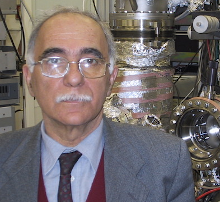
Perfetti
Paolo Perfetti was Director of the Istituto di Struttura della Materia from 1988 to 2008. Graduated in Rome in the field of Solids Physics, he was one of the main promoters of Synchrotron Light in Italy, first at the ADONE accumulation ring in Frascati, then at the Elettra laboratories in Trieste and the European ESRF laboratory in Grenoble. He has covered prestigious positions in different national and international scientific institutions and carried out academic and research activities both in Italy and abroad. He has participated in committees of numerous international conferences carrying out an intense editorial activity. His scientific experience is focused on Surface Physics, in particular direct and reverse photoemission spectroscopy, LEED, AUGER analysis and synchrotron radiation-matter interaction, with more than 250 papers in international journals. He was one of the pioneers in Italy in the field of heterojunctions and of radiation detecting and photo-emitting diodes, and the first to measure the interface parameters in heterojunctions with synchrotron radiation, and to modulate their values with thin layers of different materials at the interface. In the field of local probe scanning microscopy, he has favored the creation of a laboratory with STM, AFM and SNOM microscopes, beside the construction of several instruments for researches on inorganic materials of interest for microelectronics or sensors and biological materials. In the last years of the direction he has been extender of the scientific case for the SPARX project (Self-Amplified Pulsed Source of X Radiation) for the realization of a free electron laser.
The experience gained at Frascati saw ISM on the front line in the design and creation of the LdS laboratory “ELETTRA” in Trieste (1993). Several lines of light, that are still working at the moment, were created at that time. This allowed to obtain important scientific results in the fields of surface physics and interfaces, hybrid materials, magnetic nanostructural materials, low dimension materials and heterostructures of interest for the electronics.
Such activity had to be supported by an intensive internal research and the studies on angle-resolved photoemission, internal photoemission, optical spectroscopy, growth of thin films, diffraction and energy dispersion X-ray reflectometry, have become the main scientific themes that characterize ISM.
Another important development phase has seen ISM in the leading role in the field of local probe microscopy. In its laboratories were built the first Italian Scanning Tunneling Microscopes (STM), Atomic Force Microscopes (AFM) and Scanning Near-Field Optical Microscopy (SNOM). Several works have been published about surface studies, innovative materials and biological systems.
ISM faced a period of growth in 2003 thanks to the merger of the ICMAT Institute. This represented a choice towards interdisciplinarity that had the goal of combining the synthesis skills of new materials, proper to Chemistry, with the diagnostic skills of Physics. This disciplinary extension has enriched ISM with a valid line of theoretical research concerning surface modeling, defects and hybrid systems.
The spirit of ISM, as creator of large infrastructures, culminated with the SPARX Project (Sorgente Pulsata Autoamplificata di Radiazione X). Such ambitious project, created for the realization of a free-electron laser, started in 2002 in collaboration with INFN, ENEA, University of Tor Vergata and Regione Lazio and aimed to build a large laboratory in the area of Tor Vergata mainly focused on the analysis of ultra-fast phenomena (femto-physics and femto-chimics). Unfortunately the project was not realized because of the loss of one of the partners, but the preliminary studies were fundamental for the development of the free-electron laser at ELETTRA in Trieste.

 English (UK)
English (UK)  Italiano (Italia)
Italiano (Italia)